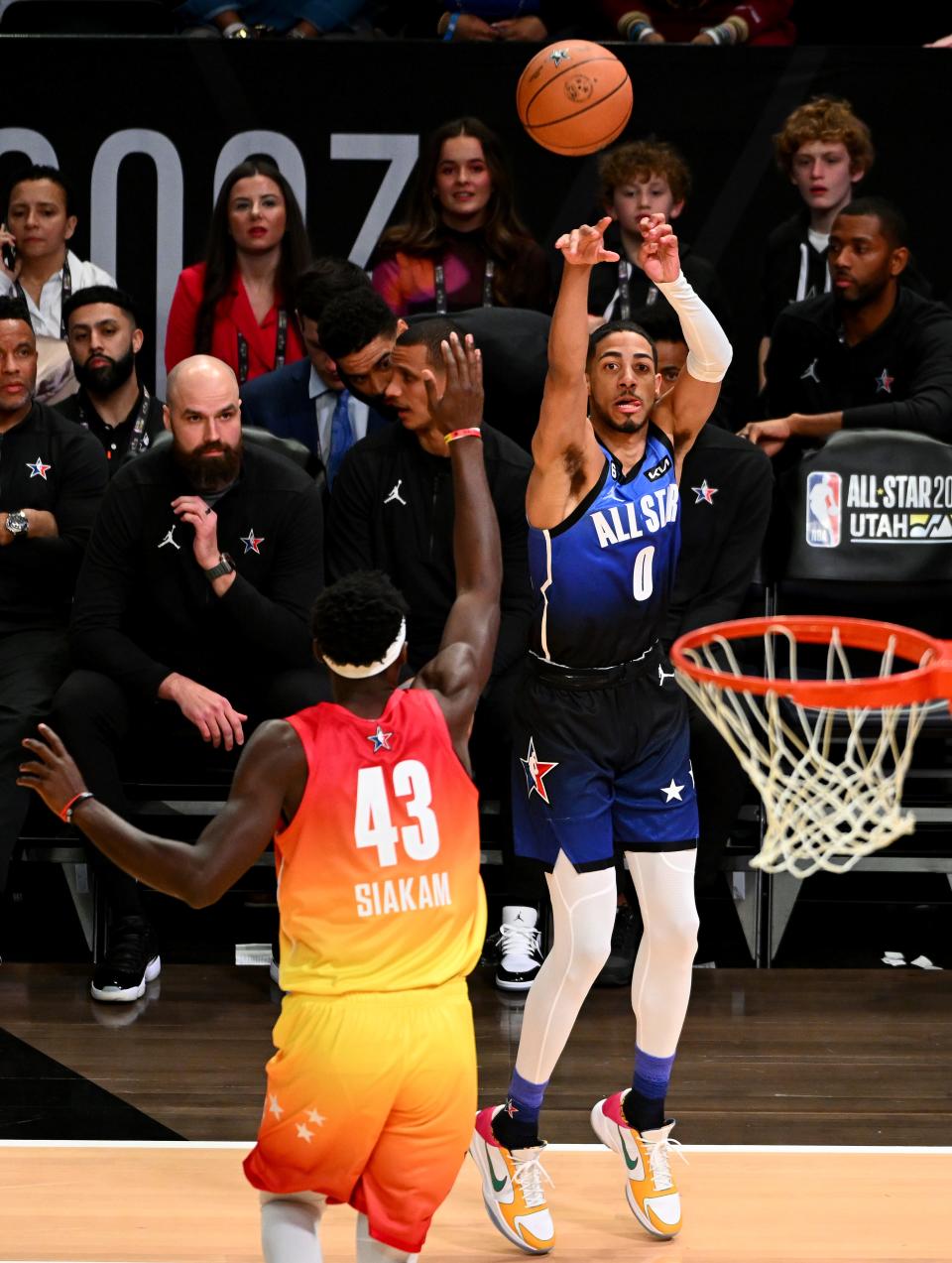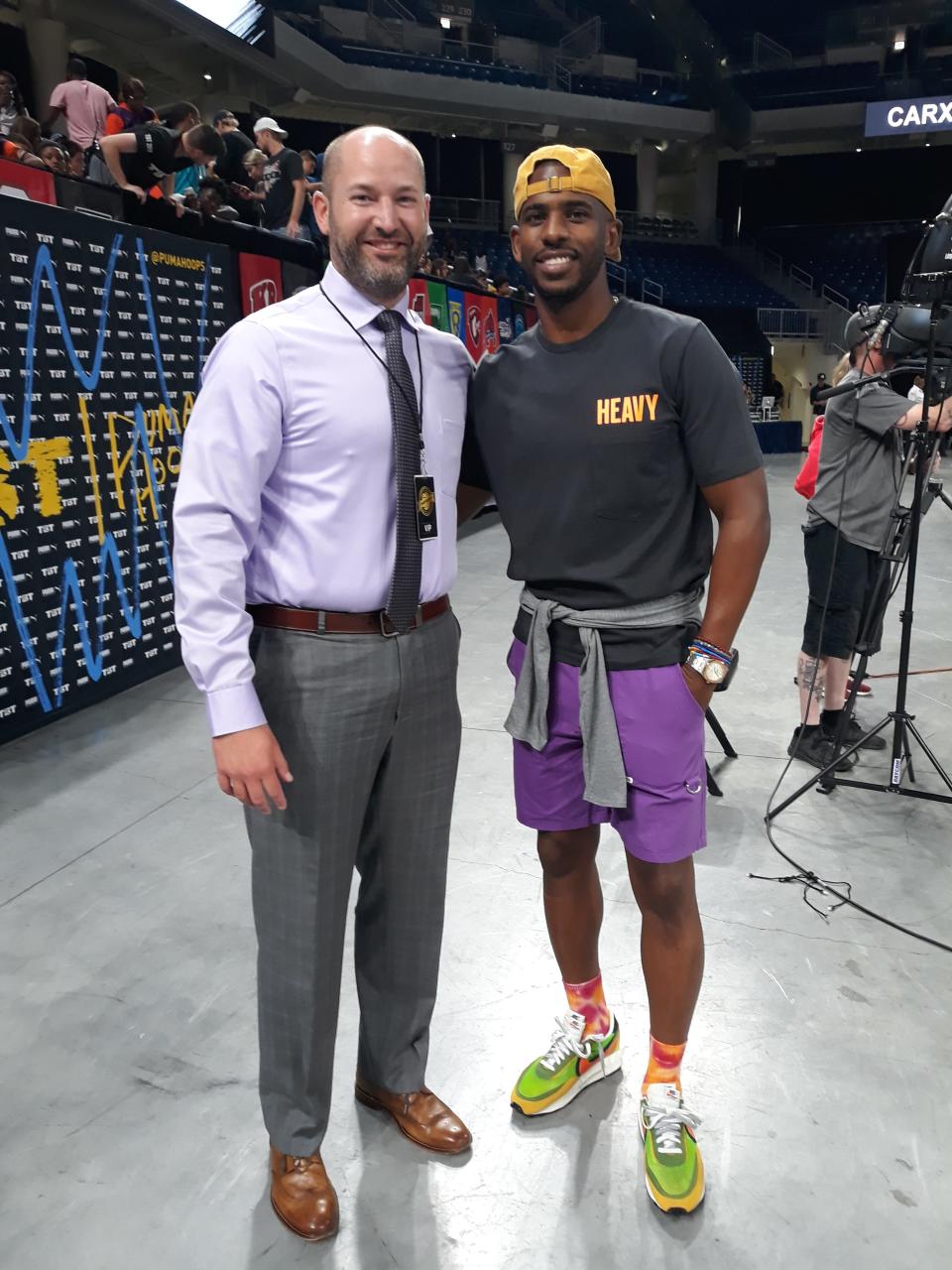NBA ends All-Star Game's clockless end. You won’t believe what Indiana man who invented it says
INDIANAPOLIS -- Nick Elam knows what he is about to say doesn't sound reasonable or logical. Most people were sure that he would be disappointed, a bit defeated and kind of deflated this week after NBA Commissioner Adam Silver announced the league was removing the so-called Elam Ending from the All-Star Game in Indy.
Elam, after all, is the man who invented the concept of a clockless finish to basketball games, a concept that was used in the last four NBA All-Star Games, after Chris Paul brought the idea to Silver for the 2020 game.
But this week, Silver said Indianapolis was the place to restore the NBA to something more traditional, an All-Star Game featuring East vs. West and a traditional scoring format.
"No tricked-up endings like we've had in the past with the so-called Elam Ending," Silver said. "It's just 48 minutes, whoever scores the most points wins."

For the past four years, the NBA has played its All-Star Game's fourth quarter without a clock and, instead, a target score to win. That target score was determined by taking the number of points the winning team had at the end of the third quarter and adding 24 points.
For example, if the winning team had 112 points at the end of the third quarter and the losing team had 103, whichever team reached 136 points in the fourth quarter would win. Time didn't matter; there was no running clock, limiting the benefits of the trailing team fouling.
But that target score ending, or Elam Ending, has been vetoed this season by Silver. Elam knows it sounds counterintuitive, but he isn't just OK with that, he is kind of happy about it. He believes that means his concept may be moving forward to an even bigger stage -- the NBA regular season.
"I know they said it was return to tradition. But I think there is a more underlying reason, and I think it's an exciting reason," said Elam, an assistant professor of educational leadership at Ball State University. "That's why, in the long run, I don't look at it as a negative thing."
Of course, Elam concedes, it would have been amazing to see the Elam Ending play out in Indiana right down the road from where he lives. But he thinks, and he has some inside knowledge, that his ending being removed from the All-Star Game is a good thing for his clockless basketball concept.

The All-Star Game, after all, is nothing more than a showcase, an exhibition game. And if the NBA were to instill the Elam Ending in the regular season, a major change in the sport, the league would want to see it used in a controlled environment where players are highly motivated to win and highly motivated to perform.
"That is not really truly shown with an exhibition like the All-Star Game. You don't really know what you're going to get. You also don't know how motivated the players are, you don't know how much of an authentic feel and style of play you're going to get," Elam told IndyStar. "I think this is the NBA's way of making sure going forward it's going to get widespread favor.
"I think this is part of the plan for untimed finishes to have a greater part in the game than they do."
'Only a matter of time'
Elam points to the NBA's G League, which is already experimenting with clockless finishes to games. This season is the second where games that go to overtime are played without a clock.
If a game is tied at the end of regulation, the overtime is played untimed until the winning team scores seven points. For example, if the teams are tied 100-100 at the end of regulation, the final target score is 107.
At the 2022 NBA G League Winter Showcase in Las Vegas, all 31 games used a 25-point final target score during an untimed fourth quarter. Under this model, the final target score was the leading team’s score after three quarters, plus 25 points.

"The G League doing it again this season? I think it's only a matter of time before that type of concept makes it into the NBA," Elam said. "I think in a counterintuitive way, the changes they've done for the All-Star Game is meant to serve that purpose."
When asked if he knows the NBA is considering a clockless finish for the regular season or if it's speculation on his part, Elam said, "It's more than speculation because the NBA, when they experiment with rules at the G League level, they don't just do that for fun.
"When they bring it back for a second season, you think real change is going to be implemented."
When asked if he has been told a time frame for the NBA implementing a clockless ending, Elam said, "I can't give you a specific time frame. I can say you only need so many years of experimenting."
Elam Ending's start: 'You see the worst basketball at the end'
Elam was an undergrad at the University of Dayton sitting around watching the NCAA tournament in 2004 with his buddies when they got to talking.
"Like so many games we had seen before, they were high quality," he said, "but when you get down to the final stretch, that's really when you see the worst basketball."
The leading team plays passively, and the losing team is rushed, taking ugly shots or repeatedly fouling with hopes the opponent will miss the free throws.
"Slim deficits are hard to overcome and makes the outcome of the game very predictable," said Elam. "What you get is a really big game and good game that just kind of fades out with a whimper."

Three years later, during the ACC Tournament semifinals in March 2007, Elam started thinking again about the cons of a timed basketball game finish.
North Carolina State upset Virginia Tech in a game Elam said was thrilling — until the end. All the air went out of the arena as Virginia Tech tried to come back by fouling. Broadcaster Dick Vitale talked about how it was a slog to the end of the game.
"The light bulb went on then," Elam said. "Maybe if you just got rid of the game clock at the end, that would address the issues."
In 2007, his research on eliminating the time element at the end of games culminated in a book, "Time's Up for Basketball's Game Clock." In it, Elam laid out different versions of what would later become known as the Elam Ending.
Among the three most popular: a completely untimed second half; an untimed fourth quarter; or Elam's current favorite, playing the final few minutes of the game without a clock.
While the NBA All-Star Games have been the highest profile league to use a version of the Elam Ending, plenty of others have implemented his finish.
'People are going to fall in love with it'
The Basketball Tournament, which was founded in 2014 as a 5-on-5 tournament in which the winning team takes home $2 million, started using the Elam Ending in 2018.
It was "a way to address deliberate fouling and stalling that often happens in late-game situations," the TBT said.

Since the Elam Ending went public 16 years ago, it's been used in leagues and camps throughout the United States. A men's league in Egypt uses the format.
"It's growing on all fronts," Elam said. "It's exciting."
In an article about the Elam Ending in the December issue of "The Basketball Times" in 2019, author Ron Morris closed by predicting that, 25 years from now, Elam would be inducted into the Naismith Memorial Basketball Hall of Fame.
As for the critics who say changing the game of basketball is a knock on the sport, Elam argues it's the exact opposite.
"The whole spirit of this concept is to continue that good, natural play that we see before the final minutes," Elam said. "I'm not trying to bash the game. I love basketball."
But with clocked finishes, "it doesn't look like real basketball at the end," Elam said. "I think what's going to happen if we see this untimed concept grow, I think people are going to fall in love with it."
Follow IndyStar sports reporter Dana Benbow on X: @DanaBenbow. Reach her via email: dbenbow@indystar.com.
This article originally appeared on Indianapolis Star: Elam ending: NBA ends All-Star Game's clockless end. Inventor responds
